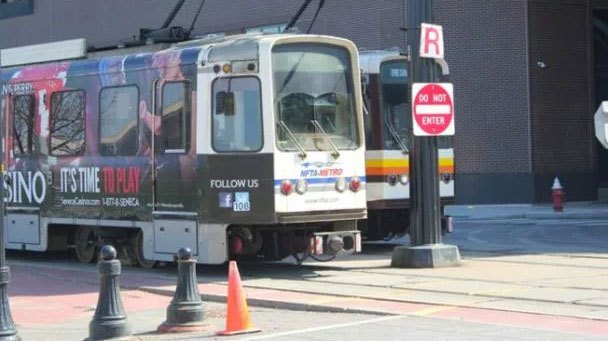Over the past few years, New York Governor Andrew Cuomo has been pouring money into Buffalo, mostly in the form of tax breaks for corporations and developers. But the job creation benefits have been underwhelming, and the subsidies are now the focal point of a federal corruption probe.
Now Cuomo is changing course. In a speech yesterday, he announced a new round of funding, and instead of tax incentives and big-ticket development projects, the focus has shifted to transit infrastructure, small-scale development, and workforce training.
Under the plan, New York would contribute funding for an extension of the city's six-mile light rail line to the University of Buffalo at Amherst. Details are still scarce, but the folks at Buffalo Rising share this description from Cuomo's office:
Develop a new commuter rail and multi-modal station in downtown Buffalo and completing Buffalo’s light rail extension to University at Buffalo’s North Campus will provide 20,000+ students access to downtown Buffalo and the waterfront, as well as connect urban job seekers with suburban employment centers, helping Buffalo to deliver economic inclusion for all the region’s workers. Additionally, a new train station will replace Buffalo’s outdated Exchange Street station which has been in need of repair for some time.
Cuomo also promised targeted interventions to bolster streets and neighborhoods:
Invest in targeted place-making improvements on key east side corridors -- Fillmore, Jefferson, Michigan and Bailey Avenues -- which will help leverage additional investment in key, historic assets such as the Central Terminal, MLK Park, and the Broadway Market. Building on the Buffalo Billion’s original $45 million investment in the Northland Corridor, Phase II proposes an additional investment for further site acquisition, brownfield remediation and place-making to further secure Northland Corridor’s future as a light manufacturing neighborhood.
Buffalo Billion Phase II proposes a transformative investment along 10 miles of Buffalo’s central spine, Main Street, from the Outer Harbor, Inner Harbor and medical campus to the University at Buffalo’s North Campus. Priority investments include: place-making and access at the outer harbor, as well as attracting a private developer to reimagine the long-vacant DL&W terminal.
It's early, and there are some glaring omissions (where is the support for Buffalo's bus network?), but this is an encouraging shift in strategy from the governor's office. Big corporate tax breaks are out, investments in transit and walkability are in. It will be interesting to see how the new approach plays out.
What we're also reading today: Green Lake Blue City compares the downtown populations of the largest U.S. cities. The Wash Cycle shares a report showing the presence of bike-share led to increases in available parking in Pittsburgh. And Georgia Bikes reports the state saw an alarming 9 percent increase in pedestrian and cyclist fatalities last year.




